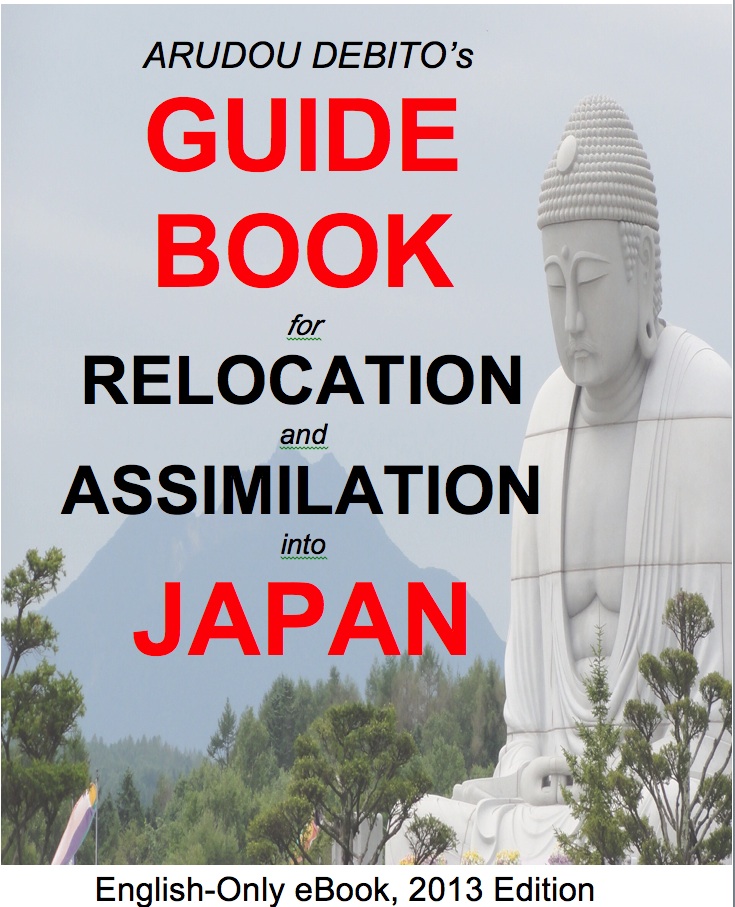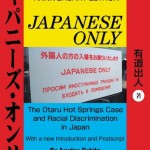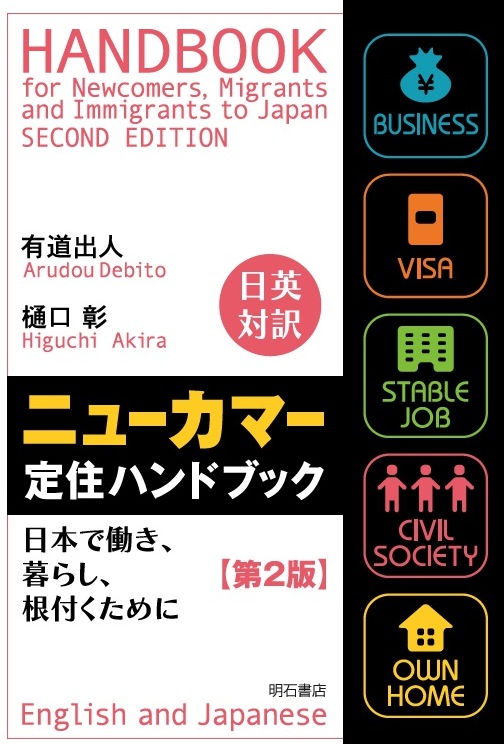mytest
Books, eBooks, and more from Dr. Debito Arudou (click on icon):





![]()


UPDATES ON TWITTER: arudoudebito
DEBITO.ORG PODCASTS on iTunes, subscribe free
“LIKE” US on Facebook at http://www.facebook.com/debitoorg
https://www.facebook.com/embeddedrcsmJapan
http://www.facebook.com/handbookimmigrants
https://www.facebook.com/JapaneseOnlyTheBook
https://www.facebook.com/BookInAppropriate
If you like what you read and discuss on Debito.org, please consider helping us stop hackers and defray maintenance costs with a little donation via my webhoster:

All donations go towards website costs only. Thanks for your support!
Hi Blog. Ten years ago I wrote a JT column on Japan’s “Hair Police”, i.e., how Japanese schools force their kids of diverse backgrounds to conform to a Wajin ideal of “black straight hair” imposed by inflexible school rules, and dye their hair black. It’s recently been revisited by the Asahi and Business Insider.com.
As I wrote back then, the damage to children is both physiological (Google “hair coloring” and “organ damage” and see what reputable sources, such as the American Journal of Epidemiology and the National Institutes of Health, have to say about side effects: lymphatic cancer, cataracts, toxins, burns from ammonium persulfate), and psychological. And yet it persists.
And not as a fringe-element trend — the majority of Tokyo high schools (the most possibly cosmopolitan of the lot) police hair color. In any case, woe betide Japan’s Visible Minorities for daring to not “look Japanese” enough. Here are the two articles, the second of which actually references my old JT column. Dr. Debito Arudou
/////////////////////////////////////////
Survey: 57% of Tokyo high schools demand hair-color proof
THE ASAHI SHIMBUN May 1, 2017, courtesy of AT
http://www.asahi.com/ajw/articles/AJ201705010035.html
Photo: Some Tokyo-run high schools ask guardians to sign and seal a form to verify students’ claims of having naturally light-colored or curly hair. (Ippei Minetoshi)
Nearly 60 percent of public high schools in Tokyo ask students with light-colored hair for proof, such as childhood photos, that these locks are their “real hair,” an Asahi Shimbun survey showed.
Many schools run by the Tokyo metropolitan government prohibit their students from dyeing or perming their hair as part of the dress code. The system of asking for “proof of real hair” was introduced to prevent schools from scolding or humiliating students whose hair is not naturally black.
The Asahi Shimbun interviewed all 173 full-time high schools run by the Tokyo metropolitan government on whether they ask students to submit forms of “proof of real hair.”
Ninety-eight of the 170 schools that responded to the survey answered “yes,” representing 57 percent of all schools contacted.
At least 19 schools ask their students to submit pictures of themselves as infants or junior high school students to prove the true color of their hair, the survey showed.
“Some students insist that their hair is natural even though it is dyed,” said a teacher at a metropolitan-run school in Setagaya Ward. “We ask their parents to confirm these claims as their responsibility.”
The style of the form varies from school to school. Most schools ask guardians to describe their children’s hair, such as, “My child’s hair is brown,” on the forms. The guardians’ seals are required to validate the information.
The number of students who submit the forms ranges from a few to a few dozen every year at each school.
Many schools hand out forms to new students who appear to have dyed or permed hair at a school information session attended by their guardians before the beginning of the academic year.
The school said the forms are intended to avoid unnecessary problems with the students if they are admitted. But the forms also show that the school is making efforts in providing “non-academic guidance.”
As the nation’s birthrate declines, competition between public schools and private schools to secure enrollees has intensified. Strict discipline can be a strong selling point.
Katsufumi Horikawa, chief of the guidance department at Tokyo’s board of education, said asking for proof of natural hair “is a valid process to prevent mistaken warnings to students (with naturally non-black or curly hair) and making them feel bad.”
However, he expressed concerns that some schools are going too far.
“Photographs are private documents, and extra consideration to protect personal rights is needed,” Horikawa said.
The education board of Saitama Prefecture, north of Tokyo, said it is “aware of the practice at several high schools.” Also in the Tokyo metropolitan area, Kanagawa and Chiba prefectures said they do not have information about the practice.
ENDS
////////////////////////////////////////////
Most Tokyo high schools demand students prove their real hair color, study finds
Business Insider.com, by Chris Weller
May 4, 2017, courtesy of BS
http://www.businessinsider.com/japanese-students-hair-color-2017-5
In the US, dress-code violations might include an offensive t-shirt or a mini skirt. In Japan, a dye job can do you in.
According to a new survey published by Tokyo news outlet The Asahi Shimbun, 57% of public high schools in the city require students to prove that their hair color is natural.
The measure is designed to uphold strict Japanese standards regarding physical appearance: In addition to prohibiting students from perming or dyeing their hair, many Japanese schools mandate crisp, respectable dress and don’t allow overly long or unkempt hair.
According to Asahi Shimbun, 98 of the 170 schools surveyed by the paper had such a policy in place. The number of children who’d been made to prove their hair color was real ranged from a few to a few dozen during the most recent school year.
“Some students insist that their hair is natural even though it is dyed,” one teacher told Asahi Simbun. “We ask their parents to confirm these claims as their responsibility.”
Unlike the US, Japan’s population is fairly homogeneous. As a result, the culture often places a premium on uniformity — even slight deviations from the norm tend to stand out, and provoke criticism in more conservative circles.
Natsuko Fujimaki, a Tokyo-based entrepreneur, says this is where the Japanese concept of majime comes into play. The term refers to a preference for order, tidiness, and often perfectionism. It tracks closely with a desire to stay reserved and sensible in comportment.
“They try to follow the rules for everything,” Fujimkai [sic] tells Business Insider.
In order to prove that a student’s hair is natural, schools will often ask parents to submit childhood photos depicting the kid’s hair color. In less extreme cases, parents only need to verify in writing (with a signature) that their child’s hair hasn’t been treated in any way.
The practice is not new. Even a decade ago, some schools required students to prove they hadn’t dyed or curled their hair. In extreme cases, schools would even require foreign-born students to dye their hair to conform to the rest of the student body as part of a forced assimilation process.
“Every week teachers would check if Nicola was dyeing her hair brown,” a Brazilian-born student named Maria told Japan Times of her sister, Nicola, in 2007. “Even though she said this is her natural color, she was instructed to straighten and dye it black. She did so once a week. But the ordeal traumatized her. She still has a complex about her appearance.”
Hair dye and perms aren’t the only beauty choices subject to Japanese dress-code standards. Many male students can’t wear spiky or messy hairstyles, allow their hair to cover their eyes, or let it grow past their collars. Some schools require female students to pin their hair back “in a way that does not interfere with classroom instruction,” as one school’s code put it.
According to Asahi Shimbun, Japan’s falling birth rate plays a role in these rules. With fewer students to fill the schools, public and private schools have started competing for parents’ attention. One strategy they’ve adopted: Highlight their strict hair policies to show how majime they are about education, in hopes parents will be impressed by the rigor.
Some critics say the requirement that students prove their hair is natural violates their privacy.
Meanwhile, advocates allege it does the students a favor, since one verification process can prevent headmasters from constantly asking whether a child’s hair is real. They say asking for initial proof ends up sparing kids even greater psychological harm.
ENDS
========================
Do you like what you read on Debito.org? Want to help keep the archive active and support Debito.org’s activities? Please consider donating a little something. More details here. Or even click on an ad below.
18 comments on “Japan’s High School Hair Police: Asahi on “Survey: 57% of Tokyo HSs demand hair-color proof”. Still.”
“One strategy they’ve adopted: Highlight their strict hair policies to show how majime they are about education, in hopes parents will be impressed by the rigor.” Or “they make kids eat pineapples to show how strict they are about soccer training.” A complete non-sequiter.
They should teach logic at school to avoid this kind of thinking. That would impress me.
Yep, Japan is so lacking in diversity awareness that anyone who doesn’t have straight, black hair ‘must’ be trying to game the system. Better get some of that ‘strict discipline’ that they think is ‘popular’ with Japan’s ‘declining population’, instead of waking up to the fact the recidivist, old fashioned, ultra-conservative, right-wing nationalism, and narrow mindedness is exactly what is causing all of Japan’s problems, without exception, including population decline.
The whole thing is utterly disgusting. They are so entrenched in ethnocentrism that they would, with a straight face, treat the completely normal human trait of diverse hair colors and types as the inherent subject of question and doubt, because that all students ought have identically straight black hair (like a Wajin) is an a priori assumption in itself beyond all doubt. It’s like an article from the Onion. Why not replace “straight black hair” with “brown eyes,” and demand all blue or green-eyed children submit proof that their eyes are real? It’s the same. Insanity.
What’s even more hilarious is that in high school anime you have characters with hair thats every color of the rainbow but heaven forbid anyone in real life have hair that isn’t perfectly straight and black.
This is just absolutely ridiculous. As a parent, I want my children’s school to concentrate on education, not what color or style of hair students have.
Also, “Some Tokyo-run high schools” is a mistake, is it not? When it’s over 50%, the correct word is not “some,” it is “most.” I like how the Business Insider article correctly addressed this, whereas the Asahi article (written by two Wajin reporters) intentionally stuck to weasel words like “some” or “many,” which fail to convey that it is indeed the majority of schools conducting this madness.
This is a classic example of punitive discipline at school. Implementing a hair-color ID policy empowers schools to single out NJ students for being different based on what they look like–instead of how they behave in classroom, by framing NJ students with natural hair color just trouble-making as some local students who dye their hairs to their own tastes. What’s even more problematic is that this kind of sensitive biological information will be kept as a part of student record. Since this kind of code is implemented as disciplinary action, it can lead to an abusive practice of hair-color witch-hunt that will add more stigma to NJ for being different.
This punitive discipline also flies in the face of reality that students don’t stick to one teacher in the classroom throughout their entire school years. They have numbers of teachers across core subjects and electives, and some of those will become their HR teacher as they move to the upper grade. Not all teachers are informed accurately and adequately about student condition. Not all schools are capable of instructing teachers to share a proper understanding for student condition. I am hardly convinced that this hair-policing will provide a substantial moral ground for schools to avoid the consequence that would bring a serious psychological wound home to students. Regarding a toxic climate of school environment for bullying and harassment and a dismally low level of school accountability for the consequence, this kind of discipline is very counterproductive to fix the problems surrounding classroom.
I guess that is why so many dye their hair once they get to university – they want to feel free, to do as they like.
This obsession extends to hair length for boys. I think at some schools their hair cannot cover their ears. Boys would get yelled at by their homeroom teachers and told to go to a barber.
Yep, Japanese schools still think they are pre-military training centers; get you hair cut! Now, let’s go back to marching around the playing field to the Totoro theme.
But what can you expect when the postwar Ministry of Education was staffed with former Kempeitai, in order to prime kids for a right wing revival when the occupation finished?
Like so many of Japan’s social ‘rules’, ‘culture’, and ‘this is Japan’ moments, it’s all a refusal to utterly reject imperial era ideology from the top down, whilst 70 years later, the masses have been BS’ed for so long, they actually believe this racism is their ‘unique culture’ that make ‘ware ware nihonjin’ special, so even though they loathe it, they don’t want kids, and about 30k commit suicide every year, they will still say ‘shouganai’ amongst themselves, and tell you to ‘go home’ if you don’t like it.
There’s no hope.
My girlfriend has a friend who is a humble office girl at a Japanese bank and one of her tasks was to sort the potential male applicants by which one’s plucked their eyebrows. Those who did would have their applications go straight into the garbage. Such a contrast to Canada where the people working at my local bank have tattoo’s.
I can also mention that I was recently working at a high school in Sagamihara, Kanagawa until March, 2016. Students would get called in to the teacher’s office and I remember a female teacher would go through students’ hair looking at the roots.
Before I had worked at a high school in west Tokyo and remember seeing a picture of a half-Japanese girl who had to bring in an old picture of her to ‘prove’ that brown was her actual hair color.
Wow. Do Japanese schools ask students of different races to dye their skin color, too?
Thing is though, apparently I have heard lots of parents don’t want schools with kids with dyed hair since it is the gateway for vice, bad attitudes etc.
But it does seem that some teachers are too zealous in the enforcement.
Then in university so many students go to university and by Golden Week there are so many freshmen with different color hair. They think it is fashionable and they want to fit in.
The hypocrisy for me is the number of teachers and parents with dyed hair. Do as I say, not as I do…
Students may not have dyed hair… unless their hair is a colour that we deem unnatural and force them to dye it a “natural” colour…
This is the logic I find bizarre.
@ Andrew, logic? In Japan? its a top down power game in which the “erai hito” decide what is “Japanese” and use that narrative to shame dissenters into doing whatever they want them to do, from dyeing their hair to an ideal black, to putting up with sexual harrassment from the boss (extreme example but not unheard of).
The idea that you can appeal to logic, or to universally accepted rules of fairness, while maybe making sense with some Japanese, just does not matter in Japan.
E.g. Japanese person “I want to quite my job but my boss won’t let me. He says maybe he will allow me to next year”.
Incredulous me “Even Japanese law says you only need to give two weeks notice or common practice is one month.”
Japanese person : “so desu ne”
Me “So just give a months written notice”
Japanese person : “No my boss will not let me”
Incredulous me “Even Japanese law says you only need to give two weeks notice or common practice is one month.”
(Conversation continues in circles until the Westerner gets bored and gives up.)
I still dont know how Japanese bosses can routinely “deny” a request to quit, and why Japanese employees go along with this.
Logic has little influence without power. Toothless anti racism/hate speech laws are toothless. Questions about whether or not Japan follows its own rule of law also arise, along with worrying similarities to China’s lack of rule of law, but I digress.
Remember what Prime Minister Pierre Trudeau said:
“There is no such thing as a model or ideal Canadian. What could be more absurd than the concept of an “all-Canadian” boy or girl? A society which emphasizes uniformity is one which creates intolerance and hate”